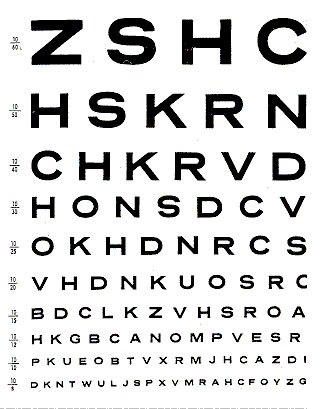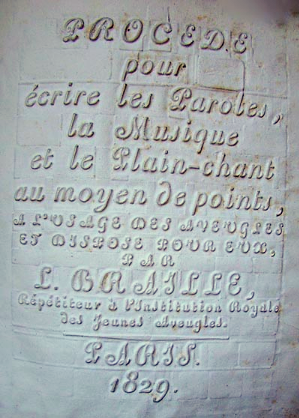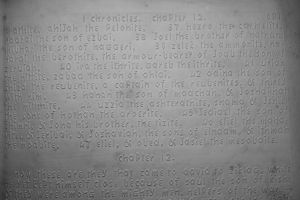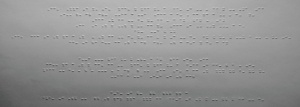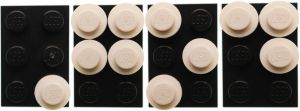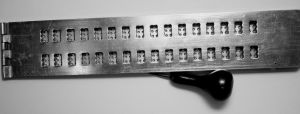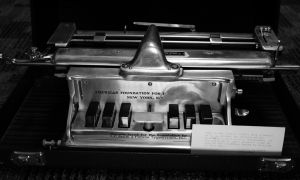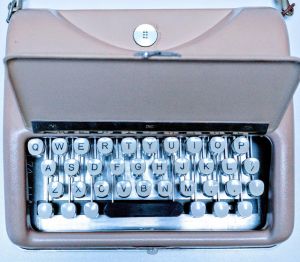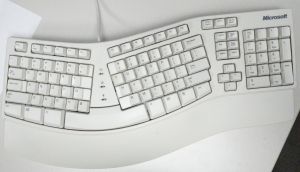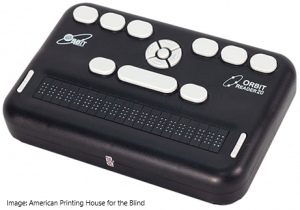AY Honors/Braille/Answer Key
1. What is a tactile reading system?
A method of printing meant to be read without sight, typically with the fingers.
2. Discuss who needs a tactile reading system and what is needed to read it.
People who are legally blind, who have a visual acuity of 20/200 or worse with corrective lenses, are typically unable to read large print or even the largest letter on an eye chart placed 20 feet away.
Here’s an additional definition from Kenneth Jernigan, longtime leader of the National Federation of the Blind: "One is blind to the extent that the individual must devise alternative techniques to do efficiently those things which he would do if he had normal vision" &.
a. Find an eye exam chart and follow the directions to test your vision. What constitutes good vision as opposed to legal blindness?
Note: This activity is not designed to diagnose visual issues. Direct students to follow up with their eye health provider regarding any vision concerns.
b. Using a multisensory activity, evaluate your epicritic sensitivity.
Activity: Do You Have Epicritic Sensitivity?
An easy way to test is to feel textures on various surfaces.
Instructors: Set up an area with commonly available items, such as sandpaper, a spiral notebook, LEGO bricks, plain and textured papers, etc. Students can test their ability to feel different textures to assess their epicritic sensitivity.
Note: Even if a person has epicritic sensitivity, it takes years for an individual to learn braille. The helpful first step is to recognize this sensitivity, followed by practice recognizing braille cells as meaningful content. Much the same way sighted children take years to learn to read and write in their native language, the acquisition of braille literacy also takes time, training, and lots of practice.
Additionally, a reasonably high epicritic sensitivity, the ability to distinguish between small variances, is helpful when reading braille. The majority of people who learn to use braille will use their fingers, though some can read it visually, and others may use another part of the body, such as the tongue when fingers lose epicritic sensitivity or if you lose fingers all together.
3. Briefly discuss the history of tactile reading systems, including the following points:
a. Who was Louis Braille?
Louis Braille was a French educator, inventor, and musician who created braille because he wanted to bridge the gap between people who are blind and people who are sighted. Louis was born in 1809 and was blinded in both eyes as the result of a childhood accident. He attended the Institut National des Jeunes Aveugles (Royal Institute for Blind Youth), which was the first specialized school in the world for people who are blind. Louis learned to read the Haüy system of raised print letters in Latin. The printing method for the Haüy system utilized wet paper and copper wire. Because of the complexity of printing Haüy, this system was virtually unusable for people who are blind as a writing system, in addition to being difficult to read.
A frustrated Louis was determined to invent a system of reading and writing that could bridge the gap in communication. "Access to communication in the widest sense is access to knowledge, and that is vitally important for us if we [the blind] are not to go on being despised or patronized by condescending sighted people. We do not need pity, nor do we need to be reminded we are vulnerable. We must be treated as equals — and communication is the way this can be brought about." - Louis Braille, 1841&
In 1821, Louis learned of a communication system devised by French Army Captain Charles Barbier, called “Night Writing,” which was comprised of a cell of up to 12 dots arranged in two columns. Part of what made this system appealing was that readers of this system could also write it without the complicated equipment other tactile fonts required at that time. Haüy, for example required copper wire and damp paper, in addition to the space to dry it.
Louis adapted Captain Barbier’s code into cells of raised dots, two across and as many as three high, completing the majority of this work by age 15. Although acknowledged by many as an ingenious and useful system, braille was not adopted by the Royal Institute for Blind Youth, and later the world over, until two years after Louis’ death at age 43.
b. List some of the tactile reading systems that competed with braille in “The War of the Dots.”
Until 1932, many tactile reading systems competed with braille, especially Moon type, New York point, and variations of braille that assigned the most frequently used letters the fewest dots. This time is referred to as “The War of The Dots.” There were so many systems, and so many changes being made to the existing systems, that in 1919 a speaker at a national convention said, "If anyone invents a new system of printing for the blind, shoot him on the spot."
Below is a list of some of the more popular systems. The list below is not exhaustive.
- Haüy: Named for Valentin Haüy, the founder of the first school for the blind in Paris, France. This is the oldest known “font” for the blind. These raised letters were more artisan than practical.
- Gall: Named for Scottish clergyman and inventor James Gall, whose “triangular alphabet” used both capital and lowercase letters.
- Boston Line Type: A raised font developed by Samuel Gridley Howe, the founder of the New England School for the Blind (later, the Perkins School for the Blind) in Massachusetts, United States. This font was styled to be easier to feel and differentiate letters.
- Moon Type: Created by William Moon, who lost much of his eyesight from scarlet fever. This font is partially based on letter shape and is somewhat alien in appearance.
- New York Point: Unlike braille, which is three dots high and two dots wide, New York Point, which was developed by William Bell Wait, was two dots high and three or four dots wide. It also had configurations for capital letters, word endings, and blends: “ing,” “ou,” “ch,” “sh,” “th,” “wh,” “ph,” and “gh.”
4. Explain how braille systems are adapted to different languages.
Unified English Braille (UEB for short, also referred to simply as braille) is a braille code that has standardized access to literary and technical material, regardless of regional dialect. As of 2013, the majority of English-speaking countries have adopted UEB. Before the international agreements to use UEB, each country used its own variations of letters, contractions, and codes for math and programming. UEB allows for easier communication among braille users, as well as with them to non-users. For example, the “@” symbol, used for email, Twitter, etc. is considered a staple in modern culture. However, there was not a standard way to represent that symbol in braille without switching to computer code braille, which was impractical to do for one symbol. UEB also has characters for italics, bold, accents, and more. This gives the reader a truer sense of what was originally written for print.
In UEB there are four grades that utilize varying levels of contractions and abbreviations. All grades have been updated to some degree from the previous versions of braille.
Note: There are braille codes for just about every language, so people can read and write in the language they speak. While many do follow the principles of assigning values of a linear script (print) to braille, some do not. For example, there are braille scripts which don't order the codes numerically at all, such as Japanese braille and Korean braille, which are based on more abstract principles of syllable composition.
| Grade 1 | This is very close to a 1:1 letter representation |
|---|---|
| Grade 2 | This is a moderately contracted code and the most like the previous version of braille |
| Grade 3 | This is a personal shorthand for taking notes and typically NOT something that would be used to communicate with anyone but yourself |
| UEB | This last version does not have grade number and is simply called UEB. This grade is highly contracted and is the goal for an international English standard. |
5. Demonstrate your understanding of a braille cell by writing your name in braille with a craft, LEGO, or other creative method.
A braille cell is a two across by three down collection of up to six raised dots. Cells can be referred to by their number designations, for example, 1 would be "a" or 125 would be "h." There are over 200 contractions to reduce the amount of space braille can take up in a book.
⠿ Indicates a full cell, whereas no dots is an empty cell and how you would represent a space. Here is the braille alphabet, punctuation, and numbers 0-9.
Note: The first 10 letters only use the top four dots.
Alphabet
| a⠁ | b⠃ | c⠉ | d⠙ | e⠑ | f⠋ | g⠛ | h⠓ | i⠊ | j⠚ |
| k⠅ | l⠇ | m⠍ | n⠝ | o⠕ | p⠏ | q⠟ | r⠗ | s⠎ | t⠞ |
| u⠥ | v⠧ | w⠺ | x⠭ | y⠽ | z⠵ |
Punctuation
| !⠖ | ‘⠄ | ,⠂ | -⠤ | .⠲ | ?⠦ |
| (⠦ | )⠴ | @⠈⠁ |
Note: The @ symbol is composed of two braille cells, using dot 4 in the first cell and dot 1 in the second.
| #⠼ | 0⠚ | 1⠁ | 2⠃ | 3⠉ | 4⠙ |
| 5⠑ | 6⠋ | 7⠛ | 8⠓ | 9⠊ |
Capital letters are denoted by a cell that has only a position 6 dot immediately preceding the capitalized letter. For example, God would be ⠠⠛⠕⠙
Example: “God” in braille, made with LEGO bricks and studs
6. Discover how braille is written.
One of the advantages of braille is that a person can learn to read and write with it. Braille can be written with a stylus and slate, braille typewriter, Tellatouch, QWERTY keyboard, and refreshable braille display or braille terminal.
Stylus and Slate: Place a sheet of paper into the slate and use the stylus to nearly puncturing the paper, using the grooves on the sides of the cell as a guide. With this method, you write right to left AND make the letters in reverse as you press the dots from the back of the sheet. The word “mat” ( ⠍⠁⠞ ) is made starting on the right side of the slate with the character, ⠩ which is the letter “m” reversed. “Mat” would look like this: (⠩⠈⠳) with the dots protruding away from you.
Note: An inexpensive slate and stylus set is available through various websites that sell products for the blind. A simple internet search will yield many retailers.
Braille Typewriter: Each key represents a different dot in a braille cell. The photo to the left is of the braille typewriter used over 100 years ago by Austin O. Wilson, founder of Christian Record Services, Inc.
Tellatouch: This machine uses a standard keyboard to output braille cells. It is used to communicate with people who are deaf-blind. Above the keyboard is a single braille cell. When a key is pressed, the braille letter raises through the metal plate.
QWERTY Keyboard: This device is nicknamed for the six-upper left alphabetical keys of a standard computer or typewriter keyboard. Some individuals who are blind use a standard computer and specialized software to access content.
Refreshable braille display: A refreshable braille display or braille terminal is much like a laptop, and this type of device enables users to input and read content. It can attach to a computer or USB drive to receive or save content. The user reads braille one line at a time by way of round-tipped pins that rise through holes in a flat surface. The user moves from one line of information to the next by pressing a directional button. Refreshable braille devices enable braille readers to use BRF, or braille format files. A braille keyboard, positioned above the reading area, is the input device for typing braille.
7. Discuss what materials might be the most helpful to have translated into braille and what you would want to be available in braille in the event you became blind.
Answers will vary according to each club and Pathfinder.
8. Identify legal and cultural provisions in your country that make braille more accessible.
In the United States, The National Library Service for the Blind and Physically Handicapped has established a network of state libraries that provide a variety of braille books including fiction, non-fiction, textbooks, and more for its members to borrow. It is also in the process of piloting a program using braille playback equipment.
The Chafee Amendment (Title 17 › Chapter 1 › § 121) allows for most printable documents and literary works to be published in braille without seeking copyright clearance.
Internationally, the Marrakesh VIP Treaty, adopted in Marrakesh, Morocco, in 2013, is paving the way for nonprofit organizations, government agencies, and others who provide copyrighted reading material to people who have been verified to have a visual impairment or other print disability. The treaty increases the availability of materials in accessible formats (braille, audio, BRF, and large print) for people who are visually impaired. This treaty requires countries which ratify it to have an exception to domestic copyright law, allowing the import and export of international content, thereby ending the obstacle of domestic copyright law. At the time of the writing of this honor, 80 countries have signed the treaty. More information is available at the World Blind Union.
9. Who was Adventist pioneer Austin O. Wilson and what did he do?
Summary:
- Lost his eyesight due to complications from contracting Diphtheria as a child.
- Learned braille from damaged printing plates.
- With approval of the General Conference Committee, created a Christian braille publication, The Christian Record, using homemade materials. The first edition was sent to subscribers in January 1900. The Christian Record (now called Christian Record) continues to be distributed today.
Founder of Christian Record Services, Inc. (DBA Christian Record Services for the Blind, DBA National Camps for Blind Children)
Note: The following selection includes adapted excerpts of an unpublished historical overview, Christian Record: Yesterday, Today, and Tomorrow by John Treolo, who worked in the organization’s communication office in the 1970s and 80s.
Austin O. Wilson, an early Adventist pioneer, was born in Ionia, Michigan, on January 27, 1873, and was raised in a Seventh-day Adventist home. (Note: The Seventh-day Adventist Church was founded just 10 years earlier.)
At age seven, Austin and his family moved to Dunbar, Nebraska, where his father had accepted a call to be a colporteur for the then Nebraska Conference. Shortly thereafter, Austin and his brother, George, contracted Diphtheria and Austin’s sight was severely impaired.
Austin was unable to continue in public schools as a result of his failing eyesight. His mother took him to Battle Creek, Michigan, to be seen by Dr. John Harvey Kellogg, but to no avail. The trip was successful in another way, as they discovered the Michigan School for the Blind in Lansing, where Austin enrolled and took classes to learn New York Point.
Thrilled with this knowledge, Austin returned to Nebraska in 1890 and completed the four-year high school course at the Nebraska City School for the Visually Handicapped. Realizing he would need a skill to earn a living, he trained to tune pianos while in school. In 1894, he moved to Chicago to put his piano-tuning skills to practice in a piano factory.
While in Chicago, Austin attended a school for Bible workers and was encouraged to return to Battle Creek to train to work for the Lord. Arriving back at Battle Creek with 25 cents in his pocket, he attended camp meeting and visited his former school. During his visit, Austin discovered a new form of tactile reading: braille. During that camp meeting, he taught himself to read braille using damaged printing plates.
As Austin began to read everything in braille he could get his fingers on, he noticed a lack of Christian reading materials. Feeling a deep burden for the spiritual needs of people who are blind, he accepted the challenge of supplying wholesome, inspirational literature to the sightless.
During this time, there were inventions to speed up the process of braille production, including the Braillewriter and the stereotyper. With these machines, Austin convinced L.T. Nicola, secretary and treasurer of the International Tract Society (forerunner to the Adventist Book Center) that embossing could be done quickly, and thus 10 tracts were made on topics ranging from "The Children’s Privilege" to "What Must I Do to be Saved?" each selling from between five and 15 cents.
Although thrilled with the progress made in providing Christian braille materials, Austin had one more hurdle to complete: a monthly Christian magazine for people who are blind.
In June 1899, Austin married Johanna Burgerson, who was also blind, and enrolled at the Iowa School for the Blind in 1887, two years before Mary Ingalls, from Little House on the Prairie fame, graduated.
Now Austin had a companion who shared his vision. Together, with G. A. Irwin, General Conference President, they pleaded [to the General Conference for funds and authorization to publish] and worked. In October 1899, the General Conference Committee gave its blessing to begin production. By January of 1900, using a washing machine hand wringer, the first 75 copies of the first issue of The Christian Record was produced in both braille and New York Point.
A yearly subscription for this monthly magazine was US$1.50 (approximately $30 in today’s money). However, even with what appeared to be a meager amount of money, The Christian Record was unaffordable for most people who were blind. An appeal was made to church leaders to collect money for these subscriptions.
In 1901, Austin reported to the General Conference Committee that subscriptions to The Christian Record had increased to 200, and each issue contained between 20 to 24 pages.
By 1907, it was reported that nearly 50 people who are blind had joined the Seventh-day Adventist Church. "These persons were not visited by Bible workers; they accepted the truth by reading the Christian Record and tracts. Already this year a goodly number have embraced the message, and many others are interested" (Lee Muck, Christian Record employee and Christian Record editor, 1902–1907, 1912–1913).
By the following year, circulation of The Christian Record had increased internationally, with subscriptions in Canada, Mexico, Australia, and England, and a readership of over 2,000. Toward the end of 1908, Austin and the Christian Record decided to take advantage of the 1904 Congressional Postal Act, enabling free shipping of embossed books and publications. One of the first books printed in braille by the Christian Record staff was the Bible. Because of this reduction in cost and successful fundraising, the $2 subscription fee for The Christian Record was removed. It has remained free for people who are blind to this day.
One prominent subscriber to The Christian Record was Helen Keller, the first deaf-blind American author, political activist, lecturer, to earn a Bachelor of Arts degree, wrote this note to the Christian Record staff:
"Dear Friends,
It is a happiness to me to know of your warm-hearted efforts to help the blind. It is help indeed — giving them light which no darkness can quench. I hope that more and more of the blind who wander comfortless in desert ways will hear the messages of love and peace which The Christian Record scatters far and wide. There is a cheery, stimulating spirit in the magazine too, and this is another greatly needed service to the sightless.
"I thank you for the sweet story which you published in the Christmas number. I am sure no one who had read it will forget its beautiful lesson.
"I rejoice in the encouragement which you have given to the blind to be as self-supporting as possible. Yes, work which they can do and do well, and in a noble spirit, is the best way to worship God and to serve their fellow men.
"Wishing you and The Christian Record continued success, I am.
"Sincerely yours,
Helen Keller"''
In 1916, Austin retired due to poor health. A year later his wife, Johanna, also resigned due to health reasons.
Note: As of the writing of this honor, The Christian Record, now titled Christian Record, continues to be produced in braille and is distributed free-of-charge to subscribers in the United States, Canada, Bermuda, and Guam-Micronesia.
10. Discuss ways to meet and interact with a person who is blind. Do one of the following:
a. Visit a facility that serves people who are blind. Before the visit, ask students to write down their predictions about their perceptions of blind people. Collect and keep responses to review after the visit.
Before the visit, ask students to write down their predictions about their perceptions of blind people. Collect and keep responses to review after the visit.
- What can a person who is blind do?
- How does a person who is blind cook, clean, etc.?
- What jobs can a person who is blind do well?
- What scares you about people who are blind?
- Are you scared of becoming blind? Why?
- Do all people who are blind see nothing? (Are there different kinds of blindness?)
b. Invite a blind person to speak to your group about his/her experiences. Before the visit, ask students to write down their predictions about their perceptions of blind people. Collect and keep responses to review after the visit.
Before the visit, ask students to write down their predictions about their perceptions of blind people. Collect and keep responses to review after the visit.
- What can a person who is blind do?
- How does a person who is blind cook, clean, etc.?
- What jobs can a person who is blind do well?
- What scares you about people who are blind?
- Are you scared of becoming blind? Why?
- Do all people who are blind see nothing? (Are there different kinds of blindness?)
Following the activity, do a club debrief. Ask the same questions as before and refer to prior responses. Ask additional questions.
- How did the person you visited read and write? Do all people who are blind read braille?
- Are you scared of people who are blind? What changed your mind?
- What surprised you from today’s visit?
- What can your club do to form a friendship with people who are blind?
- How can you share the love of Jesus with someone who is blind?
- In one sentence, share what you learned from today’s visit.
References
Additional Resources:
- As I Saw It, Robert B. Irwin, American Foundation for the Blind, 1955. Available online.
- Learn to Read Braille in One Lesson,In One Lesson YouTube channel
- Louis Braille Online Resource
- New York Institute for Special Education, “History of Writing Codes for the Blind.” Available online.
